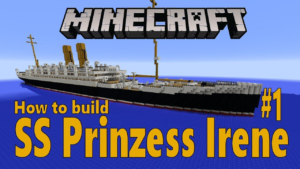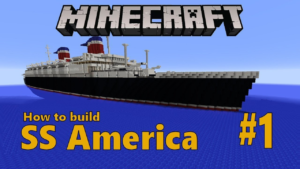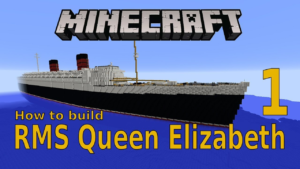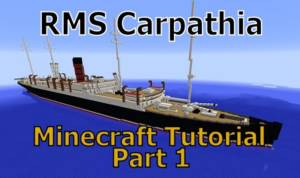The RMS Teutonic was an ocean liner built for the White Star Line in Belfast and was the first armed merchant cruiser.
During the first 18 years of service, both Teutonic and Majestic, along with their older cousins Britannic and Germanic sailed on the route from their home port of Liverpool to New York City. Each ship made on average one sailing per month, and averaged 11–14 sailings each season. The White Star Line had it planned so as they could operate a weekly service across the North Atlantic. Each week a ship sailed from Liverpool on a specific day, commonly Wednesday or Thursday. From there, they would stop at the port of Queenstown (now Cobh), Ireland, to pick up more passengers. Records have shown that Teutonic and her partner ships picked up as many as 800 Irish immigrants in a single stop, as the White Star Line was very popular in Ireland because most of their ships, including Teutonic, were Irish built.[citation needed]
After Queenstown, the ships would then continue on the long voyage to New York, almost 2,500 miles of open sea. Once passengers were disbursed at either the White Star Line pier in New York or the immigration centre at Castle Garden, and later on Ellis Island, the ship would be prepared for her return voyage.
Transatlantic races between the Teutonic and liner City of New York were common in the 19th-century. They usually began in either Queenstown Harbour or New York Harbor. On August 14, 1890, the Teutonic beat the City of New York by over three hours, and broke the ocean record by coming from Queenstown in 5 days, 19 hours, and 5 minutes, and breaking the record by 13 minutes.
In 1897 Teutonic reassumed her military role for a review commemorating Victoria's 60th anniversary. In 1898, she had a minor collision in New York Harbor with the United States Lines' Berlin, but neither ship suffered major damage.
During the Boer War in 1900, she served as a troop transport. In 1901, Teutonic encountered a tsunami, which washed two lookouts out of the crows nest who survived. The tsunami hit at night, so there were no passengers up on deck.
In 1907 Teutonic, along with Majestic, Oceanic and the new Adriatic was transferred to White Star's new 'Express Service' between Southampton and New York via Cherbourg and Queenstown. In 1911, the ship was replaced in the White Star lineup by the new Olympic and transferred to sister company Dominion Line for Canadian service. At the end of her career on White Star's UK-US services, she had carried a total of 209,466 passengers westbound[4] and another 125,720 eastbound. By 1913 Teutonic's age meant that she no longer attracted the top class passengers, and so was refitted to carry only second and third class passengers. In October 1913 the ship narrowly avoided the same fate as Titanic when, at 172 miles east of Belle Isle off the Newfoundland coast, she ran so close to an iceberg that she avoided collision only by reversing her engines and putting the helm hard aport. According to the 29 October 1913 issue of the Chicago Tribune, "the liner passed within twenty feet of the iceberg. The fog was so thick that even at that small distance the berg could scarcely be distinguished. It was so close that there was danger that the propeller of the ship would strike it as the vessel went around. The passengers were not aware of their peril until it had been averted. They signed a testimonial to the captain and his officers expressing their gratitude and admiration for the care and skill displayed by them."
In 1914, with the start of World War I, Teutonic became a merchant cruiser once again, being commissioned into the 10th Cruiser Squadron. In 1916, she was refitted with 6" guns, and served as a convoy escort ship as well as being used for troop transport.
In 1921, Teutonic was scrapped at Emden.
During the first 18 years of service, both Teutonic and Majestic, along with their older cousins Britannic and Germanic sailed on the route from their home port of Liverpool to New York City. Each ship made on average one sailing per month, and averaged 11–14 sailings each season. The White Star Line had it planned so as they could operate a weekly service across the North Atlantic. Each week a ship sailed from Liverpool on a specific day, commonly Wednesday or Thursday. From there, they would stop at the port of Queenstown (now Cobh), Ireland, to pick up more passengers. Records have shown that Teutonic and her partner ships picked up as many as 800 Irish immigrants in a single stop, as the White Star Line was very popular in Ireland because most of their ships, including Teutonic, were Irish built.[citation needed]
After Queenstown, the ships would then continue on the long voyage to New York, almost 2,500 miles of open sea. Once passengers were disbursed at either the White Star Line pier in New York or the immigration centre at Castle Garden, and later on Ellis Island, the ship would be prepared for her return voyage.
Transatlantic races between the Teutonic and liner City of New York were common in the 19th-century. They usually began in either Queenstown Harbour or New York Harbor. On August 14, 1890, the Teutonic beat the City of New York by over three hours, and broke the ocean record by coming from Queenstown in 5 days, 19 hours, and 5 minutes, and breaking the record by 13 minutes.
In 1897 Teutonic reassumed her military role for a review commemorating Victoria's 60th anniversary. In 1898, she had a minor collision in New York Harbor with the United States Lines' Berlin, but neither ship suffered major damage.
During the Boer War in 1900, she served as a troop transport. In 1901, Teutonic encountered a tsunami, which washed two lookouts out of the crows nest who survived. The tsunami hit at night, so there were no passengers up on deck.
In 1907 Teutonic, along with Majestic, Oceanic and the new Adriatic was transferred to White Star's new 'Express Service' between Southampton and New York via Cherbourg and Queenstown. In 1911, the ship was replaced in the White Star lineup by the new Olympic and transferred to sister company Dominion Line for Canadian service. At the end of her career on White Star's UK-US services, she had carried a total of 209,466 passengers westbound[4] and another 125,720 eastbound. By 1913 Teutonic's age meant that she no longer attracted the top class passengers, and so was refitted to carry only second and third class passengers. In October 1913 the ship narrowly avoided the same fate as Titanic when, at 172 miles east of Belle Isle off the Newfoundland coast, she ran so close to an iceberg that she avoided collision only by reversing her engines and putting the helm hard aport. According to the 29 October 1913 issue of the Chicago Tribune, "the liner passed within twenty feet of the iceberg. The fog was so thick that even at that small distance the berg could scarcely be distinguished. It was so close that there was danger that the propeller of the ship would strike it as the vessel went around. The passengers were not aware of their peril until it had been averted. They signed a testimonial to the captain and his officers expressing their gratitude and admiration for the care and skill displayed by them."
In 1914, with the start of World War I, Teutonic became a merchant cruiser once again, being commissioned into the 10th Cruiser Squadron. In 1916, she was refitted with 6" guns, and served as a convoy escort ship as well as being used for troop transport.
In 1921, Teutonic was scrapped at Emden.
3 video(s) found

































